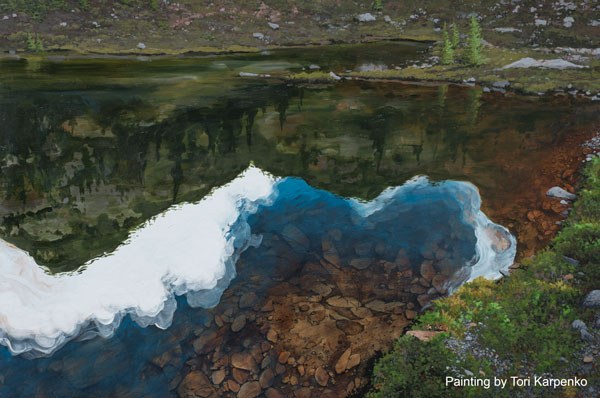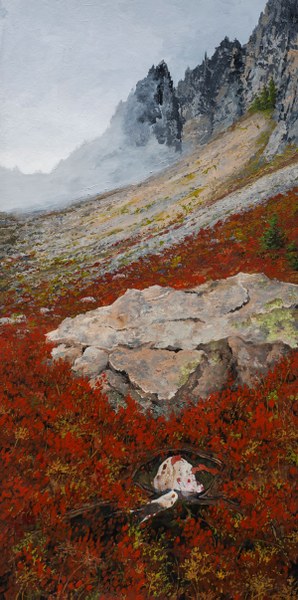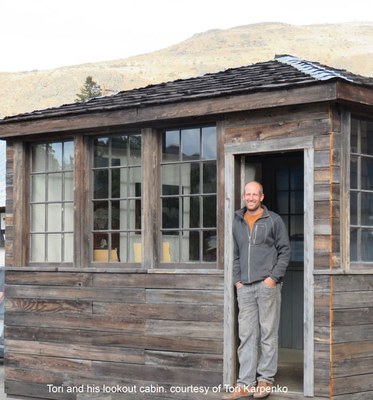
by Tori Karpenko, artist and Mountaineer
Every morning I wake to the heaviness of dread and scattered anxiety. Big life-shaking questions bombard me the minute I realize I’ve stopped dreaming. Every effort to create mental order in my overturned life is like opening closet doors only to have the contents of my life spill into a giant mess at my feet. Would I have to move away? Quit my job that I love? Leave the house that I built on eleven acres and leave behind my community and deep relationships in a giant dust-cloud of failure?
That was three years ago.
In the wake of my divorce, my young and only son moved four hours away to live with his Mom and there was nothing I could do to stop it. I was devastated. Eventually I came to grips with the fact that I needed to accept my new reality and allow myself to truly grieve but I felt lost with no map to guide me. How long is it going to take me to move on? Faced with the most difficult challenge of my life I sought solace from the ensuing emotional crisis in the North Cascade Mountains.
Tranquil Solitude
The vast silence of raw wilderness gave me a place to begin calming an anxious and grief stricken mind. One hike in particular stands out as the catalyst for the path forward. On a solo trip to Snowy Lakes in the fall of 2013, I knew there was a chance of thunderstorms but I was determined to go. Sure enough, I spent the night floating on my sleeping pad in the middle of a drowning tent as thunder echoed around the bowl of Golden Horn. After the storm I was immersed in an altered world of mist and sun play, with not a human sound to be heard for the next two days. In this remarkable setting, I discovered parts of me that were forged before the crisis. Parts that had endured other adversities — the resources needed to heal and find mental clarity buried deep inside. I just had to coax them out.
On the return hike from Snowy Lakes something started to crystalize and I saw a path emerging through the grieving process. In addition to the obvious casualties of divorce, I had drifted away from my studio practice, one of the most important disciplines I have for maintaining life balance. I hadn’t made a significant body of work in three years — a relative eternity for an artist. By the time I got back to my car I made a vow to myself that I would produce ten paintings over the course of the next year. I wanted the subject matter to express the transformation I was experiencing as I shed layers of emotional baggage by going into the wilderness.

As I began to feel the mountains coaxing me into equilibrium, a friend serendipitously shared Richard Brautigan’s poem, ‘Karma Repair Kit: Items 1-4:’
1. Get enough food to eat, ...and eat it.
2. Find a place to sleep where it is quiet, ...and sleep there.
3. Reduce intellectual and emotional noise until you arrive at the silence of yourself, ...and listen to it.
4. …
Number four is left blank. In beautiful simplicity, Brautigan’s poem captures the power of solitude and describes arriving at a tranquil, accepting state of being. By giving voice to a complete contrast of the terrifying emotional chaos I lived in, the poem became a mantra for me. As I hiked in to the mountains the agony of my mind receded and I became immersed in the silence of myself and I listened.
Along the way I discovered stories of other people who had been profoundly affected by mountain solitude. In a book titled, Poets on the Peaks, John Suiter depicts the creative and spiritual transformations of well-known beat poets Gary Snyder, Phillip Whalen, and Jack Kerouac in their years surrounding the summers they spent in the North Cascades as fire lookouts in the 1950’s.
Then I’m alone in a glass house on a ridge
Encircled by chiming mountains
With one sun roaring through the house all day
& the others crashing through the glass all night
Conscious even while sleeping
-Philip Whalen on Sourdough Lookout
Imagine the impact of 50-60 days of continuous solitude high above the tree line with abundant time to watch the mountains, explore the depths of your soul, and make art! Through their stories, the lookout cabin — one of the Pacific Northwest’s most iconic hermitages — became a crystalized symbol of the sanctuary that I too found in the mountains. I now understood the power of place-based healing, and became passionate about creating more of it.
A New Lookout
A few months into my dedicated painting endeavor a symbiotic relationship emerged between my solace treks in to the mountains and the contemplative environment of the studio. If mystical alpine experiences provided rich fodder for the studio, and the studio led to a deeper understanding and appreciation of those adventures, would it follow that even more time in both settings would amplify the cathartic healing?
Because I could not afford to escape the existing responsibilities of my life to live in a lookout on top of a mountain, I decided to bring the lookout to me in the form of a mobile studio/gallery space that I could visit and create within whenever I wanted. Over the winter months, despite many obstacles including a demanding full time job, single digit temperatures and snow, I poured countless hours in to constructing a 14’ x 14’ lookout-style cabin based on antiquated Forest Service drawings and my own observations from pilgrimages to various lookouts around the state. I repurposed 15 single-pane windows from a 1930’s era Fire Management Warehouse built by the Civilian Conservation Corps, who also built many of the fire lookouts in the Pacific Northwest in the 1930’s. As my lookout deepened with historical references, it also took on new meaning by serving as a community “creative share space” in response to the devastating 2014 Carlton Complex fires. My lookout had become a healing space not only for myself, but for others as well.
The growing body of new paintings surpassed ten and I found myself returning most often to the enchanting colors of small, pristine, and often un-named alpine lakes. Majestic and flawless, high and lonesome, they became the perfect symbol for the state of mind I’ve found through place-based healing. Countless times I’ve sat by the shore shedding layers of emotional drama, letting them metaphorically settle to a resting place at the bottom while serene, crystal clear water radiates above. In the studio, a similar regenerative focus depicting those places and the transformation that happens there brings me to a similarly quiet and uncluttered state of mind.
For me, spending time in the mountains pondering the essence of this precious purity, or to reflect deeper on those experiences in the studio, is to get in touch with the big-ness of creation, my own smallness and mortality, and the relative insignificance of my human drama in the grander scheme of things. So why not, as Kerouac says, take life as it comes and try to be more like the mountain? I now know that if it were up to me, I would fill in line number four of Braughtigan’s poem with the words: “Find something pure, ...and visit often.”
My story has some surprising silver linings. The past three years have been full of harmonious co-parenting and all three of us get to enjoy the best parts of both sides of the mountains. I see my son all the time and he is currently my favorite hiking partner, wet side or dry.
This article originally appeared in our November/December 2015 issue of Mountaineer magazine. To view the original article in magazine form and read more stories from our publication, click here.
 Tori Karpenko
Tori Karpenko
